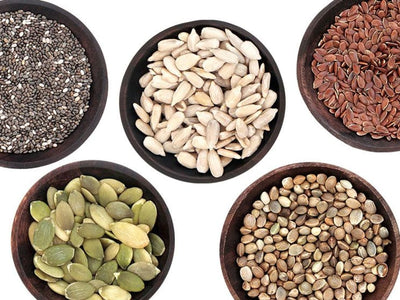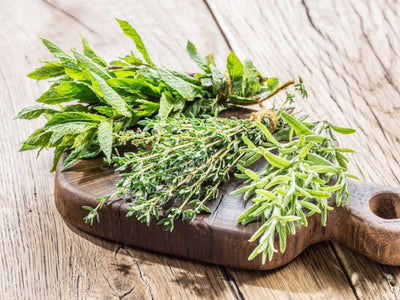Fall into Growing Food in Your Home
Posted by Drug Free Help Store on

As the growing season moves from the height of splendor to cooler months, you may not want to give up on growing food. It’s a great way to eat healthy, focus on sustainability goals and there is a certain amount sheer satisfaction when adding homegrown foods to the kitchen table.
Taking small seeds to soil, starting a jar of sprouts, making Kombucha or pickling veggies inspires both taste buds and creativity. At the Institute for Natural Medicine, our staff likes to grow nutrient-dense food in our kitchens, windowsills and yards.
Microgreens for Your Salad
Amy Rothenberg, ND, INM Staff and Contributor
I have a small love affair with microgreens, which I first spotted at my local food coop a few years back. I was drawn by their cuteness and color, but fell for their taste and texture. Microgreens made their debut in the 1980s, placed decoratively on high-end restaurant plates. Now they are more readily available at farmer’s markets and grocery stores, though often pricey. Truth is, they are inexpensive and easy to grow at home with a little time, a few materials and a modicum of patience.
Microgreens are small, usually one to three inches and are strictly speaking, young versions of familiar veggies, herbs and other ingredients. Here is a list of the most common veggie families from which microgreens are grown. You can also create some from grain or legume seeds. I add microgreens to my daily veggie count, on salads or sandwiches or thrown in a stir-fry. Research shows the nutritional value can be quite a bit higher compared to grown-up counterparts. For instance, the polyphenol content of microgreens exceeds that of many other veggies. Studies on polyphenols show they can help prevent cancer, cardiovascular illness, diabetes, bone density issues and neurodegenerative diseases.
So, how about growing your own? A sunny windowsill can work or a light-filled outdoor area. You can use a container or plant right in the ground. You want to sprinkle your seeds generously across loosened soil. Cover with just a sprinkle of more soil and water well. No need to plant in rows or painstakingly thin them out. Microgreens need 4 or 5 hours of sun a day, so consider a grow light if light is sparse. Depending on which plants you choose, you can harvest in 10-20 days. Snip the microgreens right above the soil and plant your next seeds. You do not need to remove the roots from the previous batch, they act as organic matter to feed the next batch. Growing microgreens year-round, even in cooler climates, is a fun way to keep the greens growing in your home and keep veggie variety on your plate.
Pickling and Fermenting Food
Michelle Simon PhD, ND, President and CEO
People have been pickling and fermenting foods for thousands of years. Pickling refers to immersing foods in acidic liquids resulting in a sour taste. In contrast, when we ferment food, we may also derive a sour flavor but it is the product of a chemical reaction between bacteria and the food’s inherent sugars. The latter offers health-related benefits described below.
As a way to store fruits and veggies before the advent of refrigeration, pickling and fermenting enabled families to preserve nutrition-packed foods through the winter months. Different cultures evolved different approaches to pickling. From Italy we have pickled eggplant and tomato, from Korea, we have kimchi made from radishes and other root veggies, and from Eastern Europe we find pickled cucumbers, beets and more.
Two tools from the mid 19th century endure as useful for at-home picklers. From Scotland, James Young, a chemist came up with paraffin wax, which can be used to create a perfect seal for pickled items. Around the same time, John Mason patented jars Masons jars that could withstand the high temperatures used in canning and processing pickled items.
The fermentation process uses only the item to be fermented, salt, water and passage of time (as opposed to pickling which often incorporates vinegar, other ingredients, and heat). Fermentation also gives rise to other microorganisms which help to enhance the microbiome. Making the gut microbiome more diverse and robust may well have a positive impact on the brain, the central nervous system and the immune system.
It is important to follow clear directions when pickling or fermenting fruits and vegetable. In addition to many online resources, check with your local Extension service or natural food store too, they often offer classes in pickling and fermentation.
Sprouting
Kelsang Tenpa, INM Staff
If you don’t have a lot of time or do not have ready access to a garden, you can create your own indoor garden in mason jars in a very small space. The very act of gardening alone (indoor or outdoor) has its own benefits of reducing stress and creating a happy mind. Sprouting beans such as mung and garbanzo, seeds like alfalfa, broccoli, clover, and radish, and even grains from amaranth to quinoa is easy, fun, and rewarding.
Equipment needed is minimal: a few good old-fashioned wide mouth mason jars with meshed lids and sprouting seeds that one can buy online readily or in health food stores. Instructions come with the meshed lids or can be read online. By staggering the start of a new mason jar of sprouts over a couple days, a continual harvest will be at the ready for meals. Sprouting causes an explosion of nutrients, trace elements, and essential fatty acids during germination. Sprouts are also a concentrated source of chlorophyl.
Sprouts are exceptionally nutritious and have a whole host of health benefits, “including antioxidant, antimicrobial, anti-inflammatory, antidiabetic, antihypertensive, lipid metabolism accommodation, antihypertensive, and antitumor effects.” A number of different sprouts have been shown to reduce the risk of cancer likely through antigenotoxic effects (DNA damage protection). Broccoli sprouts in particular are well known for this and they also have been shown to protect heart tissue from damage caused when blood supply returns to heart tissue after a period of time without oxygen and, in combination with zinc, protect the heart from certain instances of cardiomyopathy.
The best part though is that they are delicious topping a salad and cooked dishes like Thai Coconut Curry, in an avocado-tomato sandwich, or my personal favorite: mung bean sprouts crowning steamed yam-broccoli-parsnip-kale-ginger swimming in coconut milk added at the moment of serving … the possibilities are endless.
Written by Institute for Natural Medicine for Better Nutrition and legally licensed through the Matcha publisher network. Please direct all licensing questions to legal@getmatcha.com.



